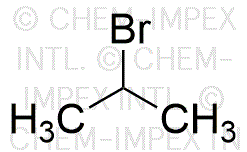2-Bromopropane is widely utilized in research focused on:
- Solvent Applications: Commonly used as a solvent in organic synthesis, 2-bromopropane effectively dissolves a variety of organic compounds, making it invaluable in laboratories for chemical reactions.
- Intermediate in Synthesis: It serves as a key intermediate in the production of pharmaceuticals and agrochemicals, facilitating the creation of complex molecules with specific biological activities.
- Reagent in Organic Chemistry: This compound is often employed as a reagent in various organic reactions, such as nucleophilic substitutions, which are critical for developing new chemical entities.
- Extraction Processes: In the extraction of natural products, 2-bromopropane is utilized due to its ability to selectively extract certain compounds, enhancing the efficiency of the extraction process.
- Research in Material Science: It is also explored in material science for developing new polymers and materials, where its unique properties can lead to innovations in product design and functionality.
General Information
Properties
Safety and Regulations
Applications
2-Bromopropane is widely utilized in research focused on:
- Solvent Applications: Commonly used as a solvent in organic synthesis, 2-bromopropane effectively dissolves a variety of organic compounds, making it invaluable in laboratories for chemical reactions.
- Intermediate in Synthesis: It serves as a key intermediate in the production of pharmaceuticals and agrochemicals, facilitating the creation of complex molecules with specific biological activities.
- Reagent in Organic Chemistry: This compound is often employed as a reagent in various organic reactions, such as nucleophilic substitutions, which are critical for developing new chemical entities.
- Extraction Processes: In the extraction of natural products, 2-bromopropane is utilized due to its ability to selectively extract certain compounds, enhancing the efficiency of the extraction process.
- Research in Material Science: It is also explored in material science for developing new polymers and materials, where its unique properties can lead to innovations in product design and functionality.
Documents
Safety Data Sheets (SDS)
The SDS provides comprehensive safety information on handling, storage, and disposal of the product.
Product Specification (PS)
The PS provides a comprehensive breakdown of the product’s properties, including chemical composition, physical state, purity, and storage requirements. It also details acceptable quality ranges and the product's intended applications.
Certificates of Analysis (COA)
Search for Certificates of Analysis (COA) by entering the products Lot Number. Lot and Batch Numbers can be found on a product’s label following the words ‘Lot’ or ‘Batch’.
*Catalog Number
*Lot Number
Certificates Of Origin (COO)
This COO confirms the country where the product was manufactured, and also details the materials and components used in it and whether it is derived from natural, synthetic, or other specific sources. This certificate may be required for customs, trade, and regulatory compliance.
*Catalog Number
*Lot Number
Safety Data Sheets (SDS)
The SDS provides comprehensive safety information on handling, storage, and disposal of the product.
DownloadProduct Specification (PS)
The PS provides a comprehensive breakdown of the product’s properties, including chemical composition, physical state, purity, and storage requirements. It also details acceptable quality ranges and the product's intended applications.
DownloadCertificates of Analysis (COA)
Search for Certificates of Analysis (COA) by entering the products Lot Number. Lot and Batch Numbers can be found on a product’s label following the words ‘Lot’ or ‘Batch’.
*Catalog Number
*Lot Number
Certificates Of Origin (COO)
This COO confirms the country where the product was manufactured, and also details the materials and components used in it and whether it is derived from natural, synthetic, or other specific sources. This certificate may be required for customs, trade, and regulatory compliance.


